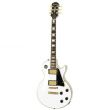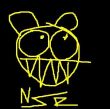i think this is the most efficient way to play a scale in two octaves, and it's how i learned. but you can play the scale any way which you see fit.
when i'm just doking around, playing scales up and down i usually play this one mentioned (* there is a typo in the second line it should be 2-3-5, not 2-3-4. the text is correct, but the tab has a typo). this pattern is very easy because you don't need to move your fingers. i.e. in this pattern, the index finger is on the 2nd fret, 3, 4, the pinky is on the 5th fret and they do not move frets.
other scale patterns involve moving your fingers to different frets. for instance one of my favorites is a 3-string scale which you can easily play 3 octaves with. attempting to write it in tab...
e:---------------------------------------8-10-12-14-15*
B:----------------------------7-8*-10-12
G:----------------------5-7-9
D:-------------4-5*-7-9
A:-------3-5-7
E:-3-5-7
the asterik-sesess indicate the root note of the scale (the beginning/end of the scale, where the next octave starts)
i'm HOPING this is correct. it's much easier for me to grasp this visually than with numberes for frets. but this is a major scale in 3 octaves that involves you working your way down the fingerboard as you progress. it's more complicated because you will be moving frets, so that's why i started with the first pattern and then worked my way to this one.




